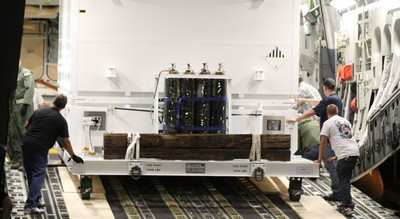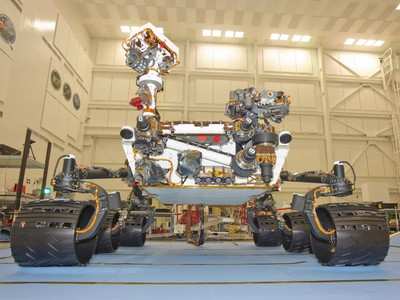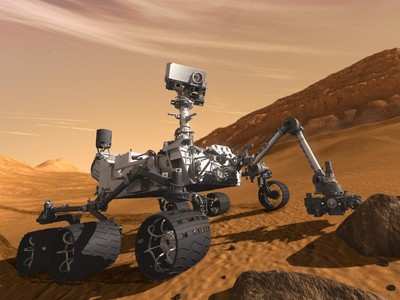Mon, Jun 27, 2011
NASA's Next Mars Rover Arrives At KSC From CA. Launch
Preparations Begin For Fall Mission
The Mars Science Laboratory rover, also known as Curiosity,
arrived late Wednesday night at NASA's Kennedy Space Center aboard
an Air Force C-17 transport plane. It was accompanied by the
rocket-powered descent stage that will fly the rover during the
final moments before landing on Mars. The C-17 flight began at
March Air Reserve Base in Riverside, CA, where the boxed hardware
had been trucked from NASA's Jet Propulsion Laboratory in Pasadena,
CA.

Curiosity Arrives On C-17 Transport
The rover's aeroshell -- the protective
covering for the trip to the Red Planet -- and the cruise stage,
which will guide it to Mars, arrived at Kennedy last month. The
mission is targeted to launch from Cape Canaveral Air Force Station
between Nov. 25 and Dec. 18. The car-size rover will land on Mars
in August 2012.
"The design and building part of the mission is nearly behind us
now," said JPL's David Gruel, who has managed Mars Science
Laboratory assembly, test and launch operations since 2007. "We're
getting to final checkouts before sending the rover on its way to
Mars."

Curiosity Before Shipping
The rover and other spacecraft components will undergo more
testing before mission staff stack them and fuel the onboard
propulsion systems. Curiosity should be enclosed in its aeroshell
for the final time in September and delivered to Kennedy's Launch
Complex 41 in early November for integration with a United Launch
Alliance Atlas V rocket.
Curiosity is about twice as long and more than five times as
heavy as any previous Mars rover. Its 10 science instruments
include two for ingesting and analyzing samples of powdered rock
delivered by the rover's robotic arm. During a prime mission
lasting one Martian year -- nearly two Earth years -- researchers
will use the rover's tools to study whether the landing region has
had environmental conditions favorable for supporting microbial
life and favorable for preserving clues about whether life
existed.

Curiosity On Mars Artist's Rendering
JPL built the rover and descent stage and manages the mission
for NASA's Science Mission Directorate in Washington. Launch
management for the mission is the responsibility of NASA's Launch
Services Program at Kennedy. The California Institute of Technology
in Pasadena manages JPL for NASA.
More News
Aero Linx: Model Aeronautical Association of Australia MAAA clubs are about fun flying, camaraderie and community. For over 75 years, the MAAA has been Australia’s largest fl>[...]
Touchdown Zone Lighting Two rows of transverse light bars located symmetrically about the runway centerline normally at 100 foot intervals. The basic system extends 3,000 feet alon>[...]
“Discovery and innovation are central to our mission at Virgin Galactic. We’re excited to build on our successful record of facilitating scientific experiments in subor>[...]
How To Get A Story On Aero-TV News/Feature Programming How do I submit a story idea or lead to Aero-TV? If you would like to submit a story idea or lead, please contact Jim Campbel>[...]
Student Pilot Reported That During Rotation, “All Of A Sudden The Back Of The Plane Kicked To The Right..." Analysis: The student pilot reported that during rotation, “>[...]
 ANN's Daily Aero-Linx (05.02.24)
ANN's Daily Aero-Linx (05.02.24) ANN's Daily Aero-Term (05.02.24): Touchdown Zone Lighting
ANN's Daily Aero-Term (05.02.24): Touchdown Zone Lighting Aero-News: Quote of the Day (05.02.24)
Aero-News: Quote of the Day (05.02.24) ANN FAQ: Contributing To Aero-TV
ANN FAQ: Contributing To Aero-TV NTSB Final Report: Cirrus Design Corp SR20
NTSB Final Report: Cirrus Design Corp SR20





